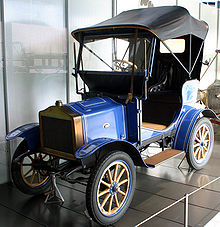Rud. Ley machine factory
| Rud. Ley Maschinenfabrik AG | |
|---|---|
| legal form | Corporation |
| founding | 1856 |
| resolution | 1947 |
| Reason for dissolution | Expropriation and dismantling after the Second World War |
| Seat | Arnstadt , Germany |
| management |
|
| Number of employees |
|
| Branch | Mechanical engineering , automobile manufacturer |
The rud. Ley Maschinenfabrik AG was a machine, automobile and commercial vehicle manufacturer in Arnstadt . The company was founded as a craft business for the manufacture of sewing and shoe machines as early as 1856 and was later bought by journeyman Rudolf Ley . In 1901 the company was taken over by his sons Alfred , Hugo , Robert and Hermann . From 1905 light motor vehicles were built there under the brand name Loreley , which Alfred Ley designed. When the legal form was converted into a stock corporation in 1909, Hermann Ley left the company. Hugo and Robert Ley switched to the supervisory board, Alfred Ley became the sole director.
history
The first Loreley was a 6/10 hp vehicle with a four-cylinder in-line engine that produced 10 hp (7.4 kW) from a displacement of 1500 cm³. Up until the outbreak of World War I in 1914, conventional touring cars with two or four seats and engines with four or six cylinders were built. In 1910 the company was the city's largest employer with 1200 employees.
After the First World War, the pre-war models initially appeared in an insignificantly different form, now under the brand name Ley . With the new T6 model, the first streamlined vehicles based on a patent from Paul Jaray were tested. At the end of 1925, the 750-employee company ran into such economic difficulties that a settlement had to be applied for to avert bankruptcy. In 1928 the construction of passenger cars was stopped, in 1933 the last trucks were delivered when the existing parts were used up.
In 1935, the site with the buildings of the automobile factory was sold in order to meet all obligations. The machines of the automobile factory were relocated to the main plant. The automobile construction department continued to manufacture spare parts and was a supplier to other automobile factories. The shoe machine manufacturing and the electrical engineering department continued unchanged until 1945.
In 1947 the company was deleted from the commercial register after being expropriated and dismantled twice. The shoe machine range was continued to be produced in 1947 in the successor VEB under the brand names SCHUMA and TEXTIMA .
Models
Loreley
| model | Construction period | cylinder | Displacement | power | wheelbase |
|---|---|---|---|---|---|
| 6/10 hp | 1905-1907 | 4 row | 1500 cc | 10 HP (7.4 kW) | 1800-2400 mm |
| J 10/25 hp | 1908-1914 | 6 row | 2599 cc | 25 HP (18 kW) | 3000 mm |
| A 5/12 PS | 1909-1911 | 4 row | 1132 cc | 12 HP (8.8 kW) | 2100 mm |
| L4A 6/18 hp | 1911-1914 | 4 row | 1545 cc | 18 hp (13.2 kW) | 2785 mm |
| 6A 6/18 hp | 1911-1914 | 6 row | 1550 cc | 18 hp (13.2 kW) | 2785 mm |
| H4A 8/21 hp | 1912-1914 | 4 row | 2068 cc | 21 hp (15.4 kW) | 2930 mm |
| K6 10/28 hp | 1912-1914 | 6 row | 2599 cc | 28 hp (20.6 kW) | 3250 mm |
Ley
| model | Construction period | cylinder | Displacement | power | wheelbase |
|---|---|---|---|---|---|
| U12 12/32 hp | 1918 - ???? | 4 row | 3091 cc | 32 HP (23.5 kW) | 3175 mm |
| T6 6/16 hp | 1920-1922 | 4 row | 1540 cc | 16 hp (11.8 kW) | 2670 mm |
| U12 12/32 hp | 1921-1923 | 4 row | 3091 cc | 32 HP (23.5 kW) | 3175 mm |
| T6E 6/20 PS | 1922-1925 | 4 row | 1540 cc | 20 hp (14.7 kW) | 2670 mm |
| U12B 12/36 hp | 1923-1924 | 4 row | 3091 cc | 36 hp (26.5 kW) | 3175 mm |
| M8 8/36 hp | 1924-1927 | 4 row | 2010 cm³ | 36 hp (26.5 kW) | 2959 mm |
| U12C 12/45 hp | 1924-1927 | 4 row | 3091 cc | 45 hp (33 kW) | 3175 mm |
| N8 8/38 hp | 1928 | 6 row | 1991 cc | 38 HP (28 kW) | 2870 mm |
| V12 12/50 hp | 1928 | 6 row | 3180 cc | 50 HP (37 kW) | 3200 mm |
literature
- Halwart Schrader : Deutsche Autos 1885–1920 , 1st edition, Motorbuch Verlag, Stuttgart 2002, ISBN 3-613-02211-7 , pp. 228–232.
- Werner Oswald : Deutsche Autos 1920–1945 , 10th edition, Motorbuch Verlag, Stuttgart 1996, ISBN 3-87943-519-7 , pp. 184-185.
- Andrea Kirchschlager, Ulrich Lappe, Peter Unger (eds.): Chronicle of Arnstadt . Kirchschlager, Arnstadt 2003, ISBN 3-934277-07-1 , pp. 332–334.
Web links
- www.ley-automobile.de, homepage of one of Alfred Ley's great-nephews
- Documents and newspaper articles on the Rud. Ley Maschinenfabrik in the press kit of the 20th century of the ZBW - Leibniz Information Center for Economics .


